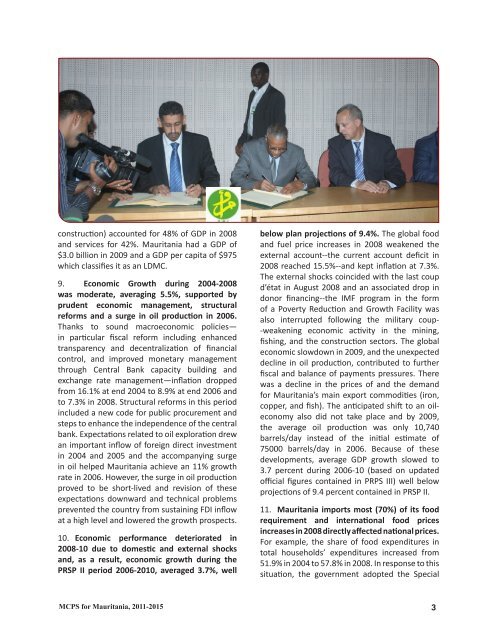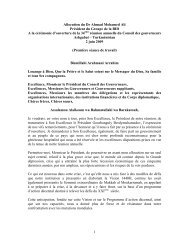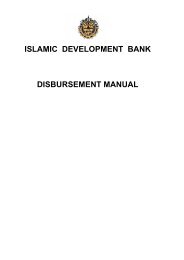Mauritania - Islamic Development Bank
Mauritania - Islamic Development Bank
Mauritania - Islamic Development Bank
You also want an ePaper? Increase the reach of your titles
YUMPU automatically turns print PDFs into web optimized ePapers that Google loves.
construction) accounted for 48% of GDP in 2008<br />
and services for 42%. <strong>Mauritania</strong> had a GDP of<br />
$3.0 billion in 2009 and a GDP per capita of $975<br />
which classifies it as an LDMC.<br />
9. Economic Growth during 2004-2008<br />
was moderate, averaging 5.5%, supported by<br />
prudent economic management, structural<br />
reforms and a surge in oil production in 2006.<br />
Thanks to sound macroeconomic policies—<br />
in particular fiscal reform including enhanced<br />
transparency and decentralization of financial<br />
control, and improved monetary management<br />
through Central <strong>Bank</strong> capacity building and<br />
exchange rate management—inflation dropped<br />
from 16.1% at end 2004 to 8.9% at end 2006 and<br />
to 7.3% in 2008. Structural reforms in this period<br />
included a new code for public procurement and<br />
steps to enhance the independence of the central<br />
bank. Expectations related to oil exploration drew<br />
an important inflow of foreign direct investment<br />
in 2004 and 2005 and the accompanying surge<br />
in oil helped <strong>Mauritania</strong> achieve an 11% growth<br />
rate in 2006. However, the surge in oil production<br />
proved to be short-lived and revision of these<br />
expectations downward and technical problems<br />
prevented the country from sustaining FDI inflow<br />
at a high level and lowered the growth prospects.<br />
10. Economic performance deteriorated in<br />
2008-10 due to domestic and external shocks<br />
and, as a result, economic growth during the<br />
PRSP II period 2006-2010, averaged 3.7%, well<br />
below plan projections of 9.4%. The global food<br />
and fuel price increases in 2008 weakened the<br />
external account--the current account deficit in<br />
2008 reached 15.5%--and kept inflation at 7.3%.<br />
The external shocks coincided with the last coup<br />
d’état in August 2008 and an associated drop in<br />
donor financing--the IMF program in the form<br />
of a Poverty Reduction and Growth Facility was<br />
also interrupted following the military coup-<br />
-weakening economic activity in the mining,<br />
fishing, and the construction sectors. The global<br />
economic slowdown in 2009, and the unexpected<br />
decline in oil production, contributed to further<br />
fiscal and balance of payments pressures. There<br />
was a decline in the prices of and the demand<br />
for <strong>Mauritania</strong>’s main export commodities (iron,<br />
copper, and fish). The anticipated shift to an oileconomy<br />
also did not take place and by 2009,<br />
the average oil production was only 10,740<br />
barrels/day instead of the initial estimate of<br />
75000 barrels/day in 2006. Because of these<br />
developments, average GDP growth slowed to<br />
3.7 percent during 2006-10 (based on updated<br />
official figures contained in PRPS III) well below<br />
projections of 9.4 percent contained in PRSP II.<br />
11. <strong>Mauritania</strong> imports most (70%) of its food<br />
requirement and international food prices<br />
increases in 2008 directly affected national prices.<br />
For example, the share of food expenditures in<br />
total households’ expenditures increased from<br />
51.9% in 2004 to 57.8% in 2008. In response to this<br />
situation, the government adopted the Special<br />
MCPS for <strong>Mauritania</strong>, 2011-2015 3






